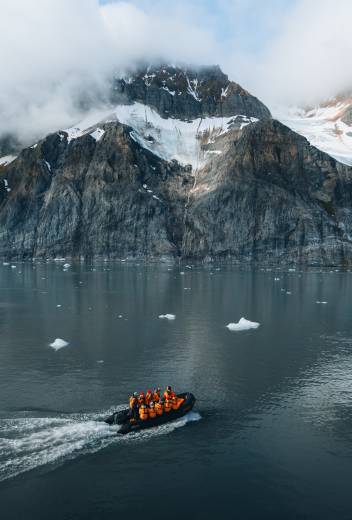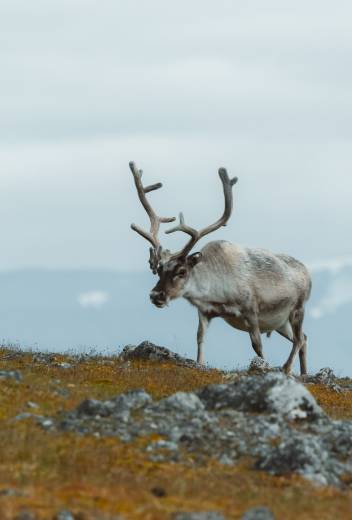The first photographs I saw of Greenland were in black and white. At a glance, I was enchanted by the ruggedness of the topography, the authenticity of the Inuit culture; a landscape so surreal that it seemed like something out of a dream. The photographers were heroes in my eyes, modern icons who merged artistic pursuit with real polar exploration.
A few years ago, I was fortunate to meet such a hero, photographer Ragnar Axelsson, whose book Last Days of the Arctic had been a favorite for years. When I looked at those pictures, those timeless black-and-white darkroom prints, I felt something profound – something like a sense of being alive.
“Go to Greenland,” he told me. “There, above all else. It’s still raw, there.”

A brilliant autumn sunrise in Gåsefjord, East Greenland.
Leaving behind the tourist bustle of Iceland, I was astounded when Greenland poured out below the airplane in the most vibrant colors of any landscape I had seen. We descended over jagged peaks like animal teeth, sweeping glaciers fracturing into a crisp blue sea. Mineral deposits painted the hills red and magenta, the tundra blooming in fall foliage. What’s more – there was no one there. A vast wilderness, 44,087 km of largely uninhabited coastline, awaited exploration.

During an expedition to Greenland with Quark Expeditions, the Ocean Nova navigates the glacial ice of Alpefjord, East Greenland.

In September, the Greenlandic tundra transforms into brilliant fall foliage, like this bearberry and willow.

Quark Expeditions passengers explore the valleys of Dream Bay, East Greenland.
Every voyage to Greenland floors me with its visual richness, where spectacular celestial phenomena and ice merge with dazzling geology and flora. Although the Greenland Ice Sheet covers 81% of the country, the coastal climate can be surprisingly warm, allowing extensive hiking opportunities across the Arctic tundra. As summer transitions to autumn, the fields of tundra flowers give way to the bright reds and yellows of fall.
Download Your Arctic Expeditions Brochure
Traveling to Greenland in September, the midnight sun of summer had come to an end. Instead, we were met with blazing sunrises and sunsets, and when the weather was clear, the chance to see the northern lights. The transitional light made it a magical time of year for photography, and as temperatures cooled, we were even greeted by pans of sea ice.

Glacial icebergs are hit with the first rays of sun near Danmark Island, East Greenland.
During a single voyage to Greenland, one can observe a massive amount of the earth’s history: the age of Greenland’s landscapes spans 3.8 billion years, the majority of geological time. From the dramatic, glaciated peaks of South Greenland, to the bright sandstone of King Oscar Fjord in East Greenland, the country’s landscapes, terrain and geology are extraordinarily diverse. Exploring the colorful striations of Skipperdal, for example, any traveler can easily become engrossed by this vast and nearly existential subject. Here, geological time becomes tangible – something travelers can see and feel.

A Quark Expeditions passenger photographs the remarkable geological formations in Skipperdal, East Greenland.

In Skipperdal, East Greenland, geology becomes engaging – even painterly.
In expedition travel, however, the most remarkable moments are often the unexpected ones: experiences that could never be planned, but arise from a wholehearted embrace of the unknown.
The expedition philosophy takes a flexible approach to itineraries, making constant adjustments based on weather, ice, and wildlife sightings, to maximize what the natural world offers every day, hour, or moment.
Sailing towards the Warming Islands one afternoon, we found our route full of sea ice, blanketing the fjord and slowing our progress. With its unpredictable movements governed by weather, current and tide, sea ice can sometimes restrict where one can sail or land – but it also forms the rich marine ecosystem favored by many Arctic animals. As we adjusted our speed and turned our attention to the ice, we were rewarded: one of our guides spotted a beautiful polar bear wandering the ice floes. All thoughts of our previous plans faded away as we spent hours watching the bear on the ice, a rare sighting in Greenland and a highlight of our trip.

A curious polar bear wanders the sea ice floes near the Warming Islands, East Greenland.
Although Greenlandic wildlife can be elusive, the expedition team is always searching – and with patience and dedication, anything is possible. Musk ox can be seen grazing in the tundra, and if you’re lucky, polar bears can be spotted wandering the coasts. A wildlife sighting in Greenland, against the backdrop of its breathtaking scenery, is well worth the wait.
From the colors of the light and land, to the luxuriant tundra and astonishing ice – there is something about Greenland that is utterly irresistible. For the photographer, the real joy lies not in taking the pictures, but in making them. It’s the expedition itself, and the experience of being there, that changes you.

A Quark Expeditions passenger takes in the sunrise in Gåsefjord, East Greenland.
After all I’ve seen in Greenland, I could never be a black-and-white photographer. The experiences one has here are too vibrant, too extraordinary. Perhaps there is nothing, truly, that can capture them – the only way is to come and see it for yourself.
Plan an expedition trip to Greenland and see the most breathtaking landscapes in the world through your own eyes. Browse itineraries today.








